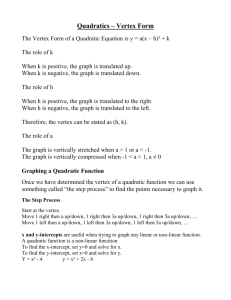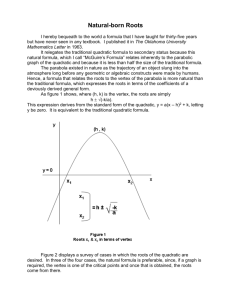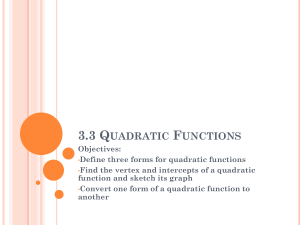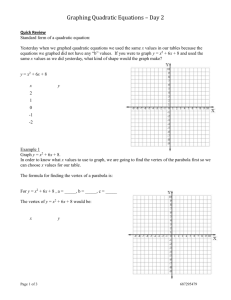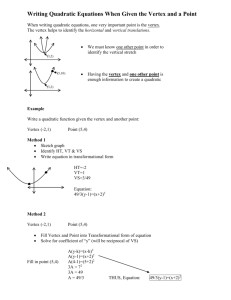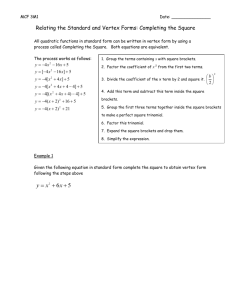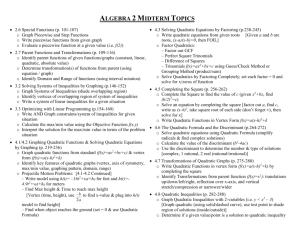Determine whether the function is linear or quadratic
advertisement
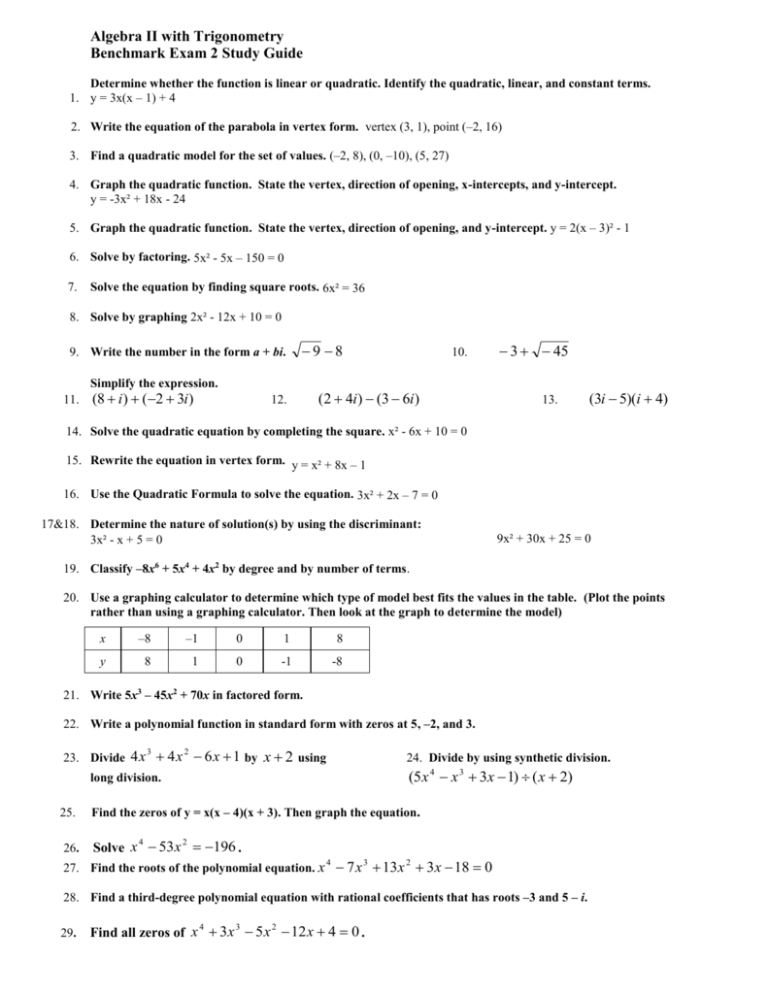
Algebra II with Trigonometry Benchmark Exam 2 Study Guide Determine whether the function is linear or quadratic. Identify the quadratic, linear, and constant terms. 1. y = 3x(x – 1) + 4 2. Write the equation of the parabola in vertex form. vertex (3, 1), point (–2, 16) 3. Find a quadratic model for the set of values. (–2, 8), (0, –10), (5, 27) 4. Graph the quadratic function. State the vertex, direction of opening, x-intercepts, and y-intercept. y = -3x² + 18x - 24 5. Graph the quadratic function. State the vertex, direction of opening, and y-intercept. y = 2(x – 3)² - 1 6. Solve by factoring. 5x² - 5x – 150 = 0 7. Solve the equation by finding square roots. 6x² = 36 8. Solve by graphing 2x² - 12x + 10 = 0 9. Write the number in the form a + bi. 9 8 Simplify the expression. 11. (8 i ) (2 3i ) 12. 10. (2 4i ) (3 6i ) 3 45 13. (3i 5)(i 4) 14. Solve the quadratic equation by completing the square. x² - 6x + 10 = 0 15. Rewrite the equation in vertex form. y = x² + 8x – 1 16. Use the Quadratic Formula to solve the equation. 3x² + 2x – 7 = 0 17&18. Determine the nature of solution(s) by using the discriminant: 3x² - x + 5 = 0 9x² + 30x + 25 = 0 19. Classify –8x6 + 5x4 + 4x2 by degree and by number of terms. 20. Use a graphing calculator to determine which type of model best fits the values in the table. (Plot the points rather than using a graphing calculator. Then look at the graph to determine the model) x –8 –1 0 1 8 y 8 1 0 -1 -8 21. Write 5x3 – 45x2 + 70x in factored form. 22. Write a polynomial function in standard form with zeros at 5, –2, and 3. 23. Divide 4 x 4 x 6 x 1 by 3 2 x 2 using 24. Divide by using synthetic division. (5 x 4 x 3 3x 1) ( x 2) long division. 25. 26. Find the zeros of y = x(x – 4)(x + 3). Then graph the equation. 4 2 Solve x 53x 196 . 27. Find the roots of the polynomial equation. x 7 x 13 x 3 x 18 0 4 3 2 28. Find a third-degree polynomial equation with rational coefficients that has roots –3 and 5 – i. 29. Find all zeros of x 4 3x 3 5 x 2 12 x 4 0 . Algebra II with Trigonometry Benchmark Exam 2 Study Guide Determine whether the function is linear or quadratic. Identify the quadratic, linear, and constant terms. 1. y = 3x(x – 1) + 4 2. Write the equation of the parabola in vertex form. vertex (3, 1), point (–2, 16) 3. Find a quadratic model for the set of values. (–2, 8), (0, –10), (5, 27) 4. Graph the quadratic function. State the vertex, direction of opening, x-intercepts, and y-intercept. y = -3x² + 18x - 24 5. Graph the quadratic function. State the vertex, direction of opening, and y-intercept. y = 2(x – 3)² - 1 6. Solve by factoring. 5x² - 5x – 150 = 0 7. Solve the equation by finding square roots. 6x² = 36 8. Solve by graphing 2x² - 12x + 10 = 0 9. Write the number in the form a + bi. 9 8 Simplify the expression. 11. (8 i ) (2 3i ) 12. 10. (2 4i ) (3 6i ) 3 45 13. (3i 5)(i 4) 14. Solve the quadratic equation by completing the square. x² - 6x + 10 = 0 15. Rewrite the equation in vertex form. y = x² + 8x – 1 16. Use the Quadratic Formula to solve the equation. 3x² + 2x – 7 = 0 17&18. Determine the nature of solution(s) by using the discriminant: 3x² - x + 5 = 0 9x² + 30x + 25 = 0 19. Classify –8x6 + 5x4 + 4x2 by degree and by number of terms. 20. Use a graphing calculator to determine which type of model best fits the values in the table. (Plot the points rather than using a graphing calculator. Then look at the graph to determine the model) x –8 –1 0 1 8 y 8 1 0 -1 -8 21. Write 5x3 – 45x2 + 70x in factored form. 22. Write a polynomial function in standard form with zeros at 5, –2, and 3. 23. Divide 4 x 4 x 6 x 1 by 3 2 x 2 using 24. Divide by using synthetic division. (5 x 4 x 3 3x 1) ( x 2) long division. 25. 26. Find the zeros of y = x(x – 4)(x + 3). Then graph the equation. 4 2 Solve x 53x 196 . 27. Find the roots of the polynomial equation. x 7 x 13 x 3 x 18 0 4 3 2 28. Find a third-degree polynomial equation with rational coefficients that has roots –3 and 5 – i. 29. Find all zeros of x 4 3x 3 5 x 2 12 x 4 0 .
